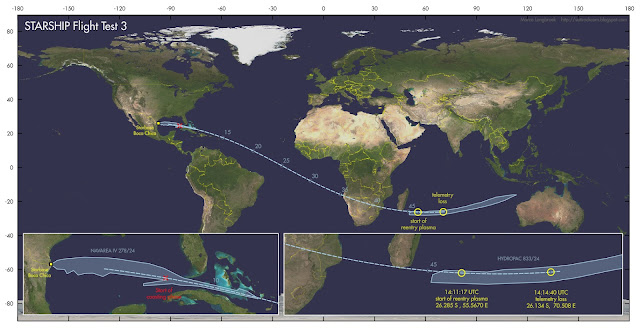 |
| NROL-70 launch trajectory. Click map to enlarge |
On 28 March 2024, if weather cooperates (see update at bottom of post), ULA will launch NROL-70 from SLC-37 at Cape Canaveral, carrying a classified payload for the National Reconnaissance Office (NRO).
NROL-70 will be the last launch of ULA's iconic Delta IV Heavy rocket. Navigational Warnings for the launch (plotted on the map above) indicate a launch to Geosynchronous orbit. The launch window opens at 17:40 UTC and runs to 22:51 UTC. Back-up dates are March 29 to April 1.
The classified payload is likely Mentor 10 (Orion 12), a Signals Intelligence (SIGINT) satellite in the ADVANCED ORION class.
The NRO launch patch for NROL-70 features a Snow Leopard:
 |
| NRO launch patch for NROL-70 |
ADVANCED ORION/MENTOR satellites are very large. At magnitude +8, they are the brightest geosynchronous satellites in the sky. In a 2010 speech a former Director of the NRO, Bruce Carlson, called one of these, the NROL-32 payload (Mentor 5), "the largest satellite in the world".
The satellites feature a very large parabolic unfoldable mesh antenna, with estimates of the size of this antenna ranging from 20 to 100 (!) meter. An NSA internal newsletter from 2009 that was leaked as part of the Snowden files, contains an artist impression of the satellite which indeed features a large mesh dish antenna:
 |
| ADVANCED ORION artist impression from a 2009 leaked NSA newsletter |
These ADVANCED ORION satellites (also known as 'Mission 7600') are huge listening 'ears' in the sky, monitoring large areas for radio emmissions, notably military COMINT (communications) and FISINT, as outlined in this leaked NSA document.
Here is an image of one of these ADVANCED ORION satellites, Mentor 4, imaged by me in January 2020. Note how much brighter it is, due to its size, than the nearby commercial geosynchronous satellite Thuraya 2 (that it is close to this commercial telecom satellite is no coincidence, see my 2016 article in The Space Review linked below):
 |
| click image to enlarge |
From the Navigational Warnings for the launch and what we know of earlier ADVANCED ORION launches (see my 2016 Space Review paper), NROL-70 will first follow a low altitude (~200 km) coasting orbit. Near the descending node, some 25 minutes after launch, it will then boost into a Geosynchronous Transfer Orbit, which some 6 hours after launch will deliver the payload to a Geosynchronous orbit.
 |
| NROL-70 launch trajectory. Click map to enlarge |
It initially will likely be placed near longitude 100 E, over Indonesia and within range of the Pine Gap facility in Australia, where it will undergo checkout. It will then be moved to its operational slot, which is unknown.
Initial control will be from the joint US/Australian Pine Gap facility in Australia. Depending on where its operational position will be, control at some point might be handed over to RAF Menwith Hill in the UK.
More backgrounds on the role of these kind of SIGINT satellites can be found in this 2016 article in The Intercept and in my 2016 article in The Space Review.
Here is the text of the relevant Navigational Warning (the three hazard areas A, B and C have been plotted by me as red boxes in the map above):
191855Z MAR 24
NAVAREA IV 333/24(GEN).
NORTH ATLANTIC.
FLORIDA.
1. HAZARDOUS OPERATIONS, ROCKET LAUNCHING
281740Z TO 282251Z MAR, ALTERNATE
291737Z TO 292251Z MAR AND 011725Z TO 012251Z
APR IN AREAS BOUND BY:
A. 28-34.73N 080-34.39W, 28-37.00N 080-20.00W,
28-34.00N 079-44.00W, 28-30.00N 079-45.00W,
28-28.00N 080-20.00W, 28-28.88N 080-32.26W,
28-30.00N 080-32.80W, 28-33.65N 080-34.05W.
B. 28-31.00N 073-23.00W, 28-22.00N 070-35.00W,
27-51.00N 070-38.00W, 27-58.00N 073-22.00W.
C. 22-05.00N 042-25.00W, 22-29.00N 042-17.00W,
20-36.00N 036-57.00W, 20-22.00N 037-03.00W.
2. CANCEL THIS MSG 012351Z APR 24.
Below are very approximate orbit estimates for the various phases of the launch. They are valid for launch on 28 March 2024, 17:40 UTC:
NROL-70 COASTING PHASE (valid 17:45-18:05 UTC)
1 70000U 24999A 24088.73611111 .00000000 00000-0 00000-0 0 06
2 70000 028.4000 281.1702 0007584 097.3393 339.7290 16.21678257 00
NROL-70 GTO PHASE (valid 18:05-23:30 UTC)
1 70001U 24999A 24088.75364583 .00000000 00000-0 00000-0 0 07
2 70001 028.4000 281.0464 7360043 179.7976 360.0000 02.21326367 09
MENTOR 10 initial placement guess (valid from 23:30 UTC)
1 70002U 24999A 24088.98149645 0.00000000 00000-0 00000+0 0 02
2 70002 5.0000 278.2000 0001186 360.0000 2.0110 1.00277482 05
The last, Geosynchronous orbit assumes initial orbit placement at longitude 100 E at an initial orbital inclination of 5 degrees.
NRO Press kit for NROL-70
ULA Press kit for NROL-70
UPDATE 27 March 17:35 UTC:
Currently the weather forecast for 28 March does not look very positive, so launch might be postponed.




















